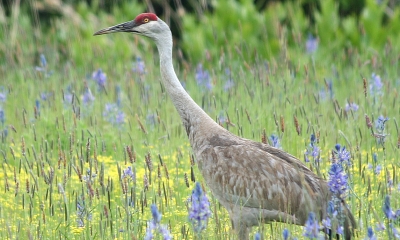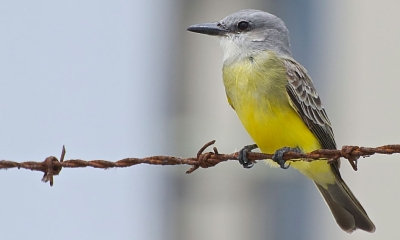
Birds
With a state as diverse in habitat and landscape as Oregon, bird watching is phenomenal. It's a fun activity you can do from home in your own backyard or you can travel to one of ODFW's Wildlife Areas or National Wildlife Refuges located around the state. Bird watching is also a relatively easy way to connect with nature and learn more about Oregon's bird populations, from shore birds to desert species.
Types of Birds

Bitterns, herons, and egrets are all long-legged wading birds with long necks and pointed bills for spearing fish or other prey.

Secretive little birds, wrens creep through vegetation and take flight in erratic patterns. Kinglets are insectivores.

Oregon has a variety of raptors, from the diminutive Sharp-shinned hawk to our nation's symbol, the Bald eagle. Some of these birds of prey are migratory, while many live here year-round and can be seen hunting along rivers, roadside posts and fields.

You'll find rails, coots and cranes in marshy areas feeding on plants and small animals. Oregon has two species of rails, one coot and one crane.

This group includes the European starling which is considered an invasive species in Oregon.

Oregon has many different species of shorebirds, and they live near waterbodies from the ocean to the desert. Shorebirds are easily identified by their small to medium-sized bodies with long legs and thin bills. Location and habitat use, bill shape and body proportions help identify individual species.

Although called warblers, many of these perching birds may not necessarily be closely related to one another. They are usually easier to hear than see.

Gulls and terns can be seen year-round in Oregon, depending on the species. Gulls like open areas around water bodies and are frequently seen where human food is concentrated, such as dumps or restaurants. Terns are in the same family and usually are smaller and more slender.

The Western tanager is Oregon's only species of tanager. It lives in wooded habitat throughout the state.

Murres, auklets and puffins are all sea birds that only come ashore to nest. The most unique is the Marbled murrelet which flies inland - sometimes great distances - to nest in coastal coniferous forests.

Towhees, sparrows, grosbeaks and buntings are ground-dwelling birds that are typically drab looking. They feed on insects in summer and seeds in winter.

Pigeons and doves are a familiar sight, daintily walking and bobbing their heads. Rock pigeons and Eurasian collared-doves are natives of Europe while Band-tailed pigeons and Mourning doves are native to Oregon.

Observers can see mixed flocks of Oregon's four species of blackbirds, the Great-tailed grackle and the Brown-headed cowbird.

Oregon's owls are mostly nocturnal, hunting for insects, fish, frogs, birds, mice and other small mammals in the night. Their hoots, screeches and calls can be heard after dark or early in the morning.
Owls don't build nests, but instead use tree cavities, nests created by other species, naturally occurring structures or human-made nest platforms. The Western burrowing owl nests underground in abandoned dens dug by squirrels, prairie dogs and badgers.
Learn more about Oregon's owls.

Small to medium-sized, finches have relatively pointed wings and sparrowlike bills. They have notched, short tails and and constantly give calls in flight.

With long, pointed wings, nighthawks can sometimes be seen during the day catching insects while in flight although most are active at night. Nighthawks roost by scraping the ground or roost on low branches. Nestlings can fly at 10 days old.
Swifts nest on vertical walls, such as chimneys or old smoke stacks, hollow trees or rock crevices. It's fun to watch them at dusk in summer, circling their nesting site. These birds are never seen perched, but only in flight.

Hummingbirds are a popular backyard bird watching species, especially at hummingbird feeders. ODFW advises making your own feed to avoid commercial mixes that contain red dye.
Hummingbirds swoop and dive with most performing a low back-and-forth movement called a shuttle display. Feeding on flower nectar, hummingbirds often are stained with pollen and are an important pollinator.

Oregon has one species of kingfisher, the raucous Belted kingfisher and 12 woodpecker species. Six woodpeckers are Oregon Conservation Strategy Species of management concern and in need of conservation.
Famous for their hammering and hole drilling, woodpeckers might decide your home looks like a good place to set up shop. Learn how to discourage this on our Living with Wildlife, Birds page.

Plumage and structure of flycatchers is so similar that their call is the primary field mark. Oregon has one lark species, the Horned lark that breeds in small scattered populations throughout the Willamette Valley. The Western meadowlark is in a different family and is related to the blackbird, grackle and oriole.

Swans, ducks and geese belong to the Anatidae family and occur on all continents. Special oils let their feathers shed water, so they are adapted for swimming and floating, and some are even talented divers.
For tips on discouraging geese from overwhelming your yard, check our Living with Wildlife, Birds page.

Vireos and shrikes are predatory song birds. Their bills are strong and hooked to kill and dismember prey including insects and small birds, mammals and reptiles. These birds hunt from fences, wires and treetops and sometimes hang captured prey on thorns to eat them later.

Pheasants, grouse, quail and turkey are all upland game birds that are chicken-like and ground-dwelling. Wild turkeys are the largest upland game bird in Oregon.

These birds are intelligent, curious, social and have good memories. Members of this group are commonly called the crow family, and are the among the most intelligent birds studied so far.

These diving birds are built for living on the water, floating low on the surface with legs farther to the rear to help propel them underwater. Loons have webbed feet, grebes have lobed toes.

Swallows and martins have smooth flights patterns, pointed wings, forked tails and feed almost entirely on the wing.

Oregon has two species of pelicans, American white and the Brown pelican, and three species of cormorants. All are fish-eating water birds with four toes joined by webbing.
Depending on the species, pelicans and cormorants inhabit the Oregon coast, rivers or interior waterbodies.

Fun little birds to watch, chickadees and nuthatches are common in Oregon. With short, strong bills, they feed on insects and seeds and are often seen in groups.


